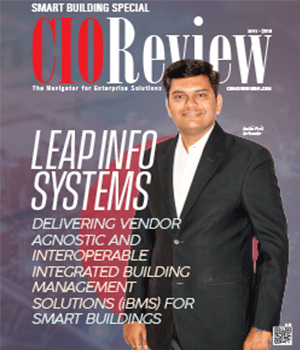
Cloud Is for Everyone
Sandeep Jamdagni, Head IT, Ashiana Housing Ltd | Thursday, 15 November 2018, 05:51 IST
 Every IT organization is having their own approach for utilizing the power and economics of cloud computing. The question that comes in mind of every CIO or IT Leader is how to move on cloud. Those who are already utilizing power cloud computing want to optimize the solution and usage. Biggest challenge faced by IT leaders, while moving towards cloud computing is the buy-in with management for the solution. Most of the senior cadres CEO/CFO/MD consider moving towards cloud as a significant step towards IT cost reduction. IT leaders are expected to show reduction in IT budget while promoting cloud computing. The story, whereas is totally different. The biggest motivator for IT leaders is to increase IT agility, quick deployment followed by reducing capital expenses. Cloud services on the other hand, are often about avoidance of further new investment in data centers.
Every IT organization is having their own approach for utilizing the power and economics of cloud computing. The question that comes in mind of every CIO or IT Leader is how to move on cloud. Those who are already utilizing power cloud computing want to optimize the solution and usage. Biggest challenge faced by IT leaders, while moving towards cloud computing is the buy-in with management for the solution. Most of the senior cadres CEO/CFO/MD consider moving towards cloud as a significant step towards IT cost reduction. IT leaders are expected to show reduction in IT budget while promoting cloud computing. The story, whereas is totally different. The biggest motivator for IT leaders is to increase IT agility, quick deployment followed by reducing capital expenses. Cloud services on the other hand, are often about avoidance of further new investment in data centers.
Clouds save money but the real ROI is the availability and agility of services. The environment which may cost too much to SME’s, is available on usage cost basis. 24X7 Technical manpower and secure virtual data center is another buy in. Another major benefit which come along are Agility, Quick commissioning and worry free ‘up-scaling’ of the capacity. Whereas on-premise IT infrastructure require capital investment in data-centers, UPS power and cooling, Rack space and trained human resources. Capacity increment or new server procurement always lead to start of a all new project with capacity planning than vendor selection to quotationsnegotiations and limited rack space in data center. For the first time movers on clouds, a conservative approach is more suitable. Starting with non-critical applications on cloud and having the flavor of the cloud, services and concepts move moderately. CIO INSIGHTS CLOUD IS FOR EVERYONE By Sandeep Jamdagni, Head IT, Ashiana Housing Ltd One should consider some research with team and peers before moving towards cloud services. Move should not be considered only for the sake of new technology and cost saving, a proper assessment of service requirement should be done.
One thing is clear, small companies approach the cloud differently than mid-sized and large enterprises. Public clouds, LaaS is accessing Virtual machines in shared environment. Require capacity in the form of server, storage and network infrastructure as a service.
For small companies, moving email services and corporate website on public cloud is an easy move. Whereas mid-size to large companies which have already deployed cloud servers and already reaping the benefit of cloud services are moving for Private or Hybrid cloud services.
Small companies moving towards the public cloud may consider few points while selecting the right partner.
• Will it meet your security/ compliance needs
• Will the computing resources are scalable and flexible enough to suit workload needs and match Peak performance levels
• Sufficient data networking performance and bandwidth in peak usage
• Adequate computing power in peak utilizations
• Can it migrate workloads between in-house systems and cloud providers
• How billing will be done. Initial prefer for Pay-Per- Use model
Hybrid cloud can be considered as a second step in moving further into cloud computing. This is the upcoming and most talked about platform for new cloud investments. It is enabled by cloud platform management suites. It's a combination of on - premise and offpremise infrastructure, avoiding further data center expansion and reducing overall cost and scalability as well as availability. The applications being managed are similar, with databases, web sites, and business critical apps ERP/CRM on top of the list. These workloads are natural for hybrid cloud deployment, whereas onpremises servers and applications can be burst into the cloud VM's in their peak utilization periods.
To be real, it will require management tools that span your on premise private cloud and your public LaaS assets. To manage both infrastructures in one platform, you will need to have a cloud platform suite, which can sync both the platforms on real-time with secure data movements.
Followings can be considered while opting for a better Hybrid cloud and cloud management tool.
• Information and data Security ( Most considered aspect, as data will be IN-OUT)
• Scalability and Provisioning, computing power in peak utilizations and for future developments.
• Integration with existing infrastructure management tools and Integration with other solution APIs.
• Ability to manage on-premises and off-premises workloads
• Monitoring and Performance management
• Capacity management
• Ease of configuration and change management
Private cloud where companies put their all or most critical application on cloud, but accessed privately, no sharing of the resources happens here. Organizations believed to be more advanced on their information security services. Organizations which are doing Authentication Authorizing and Accounting of each data byte being accessed or moved into their environment. For such organizations security remains the top concern followed closely by fundamentals, such as the ability to control of your virtual machines and their associated storage, make configuration changes and manage your capacity effectively. It can be viewed as same security measures as they were deployed in their on-premise data center, before virtualization.
In-house deployment or moving towards private cloud platform, organizations should debate on following points.
• Security of solution deployed.
• Application monitoring 24X7
• Performance monitoring of the deployed platform and applications.
• Provisioning of the new required VM with pace.
• Automation of the process, deployment and configuration.
• Identity management/sign of who is accessing what.
• Cost control of the solution with pre-mentioned budgets.
• Integration with public cloud.
• Cost modeling/chargeback or show back
• Create a single management console
Cloud is the future not only for startups and SME's but also creating value for large organization.
CIO Viewpoint
By Sandeep Jamdagni, Head IT, Ashiana Housing Ltd
How Google Map Api and Android Based Mobile...
By Aryan Panchal, Group Head IT, Ashok Piramal Group
CXO Insights
Minimizing the Effects of Bad Data in Big Data...
By Govind Seshadari, Vice President - Technology, Epsilon
Internet of Things--Managing Projects
By Vikrant Sankhe, General Manager Key Account Management, Siemens
Grey Chatter: Leading Into a World of...



.jpg)



